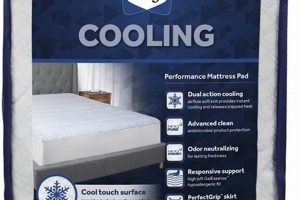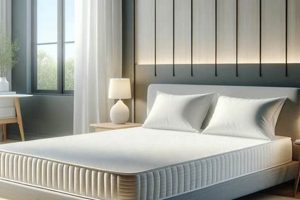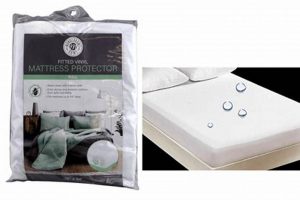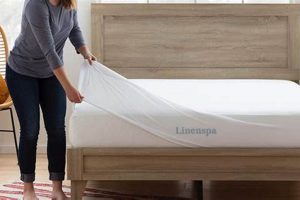This item is a fitted or encased covering designed to shield a bed surface from fluids, stains, allergens, and general wear and tear. As the name suggests, it can be cleaned via machine washing, offering convenience and hygiene. Consider, for instance, a scenario where accidental spills occur; this covering would prevent liquid from penetrating the mattress itself, which could lead to mold growth or permanent staining.
The significance of such a protective layer resides in extending the lifespan of the underlying bedding, maintaining a cleaner sleep environment, and potentially reducing allergy symptoms. Historically, similar bed coverings were initially crafted from basic materials for simple protection. Modern iterations leverage advanced fabrics and manufacturing techniques to offer enhanced breathability, waterproofing, and overall comfort, thus becoming an integral part of bedding ensembles.
The ensuing discussion will delve into the various types available, materials employed in their construction, factors to consider when selecting one, and best practices for laundering and maintaining optimal performance. Further exploration will encompass considerations for specific needs, such as those related to children, individuals with allergies, or healthcare settings.
Tips for Selecting and Maintaining a Bedding Shield
Optimizing the lifespan and effectiveness of a bedding shield requires careful selection and consistent maintenance. The following tips provide guidance for ensuring both hygiene and longevity.
Tip 1: Material Considerations. The material impacts breathability, water resistance, and overall comfort. Options range from cotton and polyester blends to specialized waterproof membranes like polyurethane. Evaluate the intended use and prioritize materials accordingly. For example, individuals prone to night sweats may benefit from a breathable cotton top layer.
Tip 2: Waterproofing Technologies. Not all waterproof options are created equal. Some utilize laminates, while others rely on tightly woven fabrics. Research the specific waterproofing technology to understand its effectiveness and potential drawbacks, such as noise or reduced airflow.
Tip 3: Fit and Encasement. A proper fit is crucial. Ensure the chosen size corresponds to the mattress dimensions. Encasement styles, which fully enclose the mattress, offer superior protection against allergens and bed bugs compared to fitted sheet styles.
Tip 4: Washing Frequency. Regular laundering is essential. Aim to wash the bedding shield every one to two months, or more frequently if spills or accidents occur. Consult the manufacturer’s instructions for specific washing guidelines.
Tip 5: Drying Methods. High heat can damage certain materials, particularly waterproof membranes. Air drying or tumble drying on a low setting is generally recommended. Always check the care label before drying.
Tip 6: Avoid Harsh Chemicals. Bleach and harsh detergents can degrade the protective qualities of the shield. Opt for mild, fragrance-free detergents to preserve the material’s integrity.
Tip 7: Check for Damage. Periodically inspect the shield for tears or punctures. Even small damages can compromise its protective capabilities. Replace the shield if any significant damage is detected.
Following these guidelines will extend the life of the bedding shield, ensure optimal hygiene, and protect the investment in the mattress it is designed to safeguard.
The subsequent section will address specialized types of bedding shields and their unique applications.
1. Waterproof Barrier
The inclusion of a waterproof barrier is a defining characteristic of many mattress protectors designed for preventing liquid damage to the underlying mattress. This functionality directly impacts the hygiene, longevity, and overall condition of the bedding.
- Mechanism of Protection
The core function of a waterproof layer within a washable mattress protector lies in its ability to physically block liquids from penetrating the mattress. This barrier typically consists of a thin, non-porous membrane, often made of materials like polyurethane or polyethylene. In the event of a spill, the liquid remains on the surface of the protector, allowing for immediate cleanup and preventing absorption into the mattress fibers.
- Material Composition and Breathability
While waterproofing is essential, the material composition of the barrier is crucial for user comfort. Early waterproof protectors often lacked breathability, leading to overheating and discomfort. Modern designs incorporate breathable waterproof membranes or combine waterproof layers with absorbent, breathable top layers, such as cotton or bamboo. This balance ensures liquid protection without compromising sleep quality.
- Hygiene and Allergen Control
The waterproof barrier contributes significantly to mattress hygiene. By preventing liquid absorption, it inhibits the growth of mold, mildew, and bacteria within the mattress core. Furthermore, the barrier acts as a defense against allergens, preventing dust mites, pet dander, and other irritants from infiltrating the mattress. This feature is particularly beneficial for individuals with allergies or asthma.
- Maintenance and Durability
The effectiveness of the waterproof barrier is directly linked to its durability and proper maintenance. Repeated washing and drying can degrade the waterproof membrane over time, reducing its effectiveness. Following the manufacturer’s care instructions, avoiding harsh detergents and high heat, and promptly addressing any tears or punctures will prolong the lifespan of the barrier and maintain its protective qualities.
The presence and quality of a waterproof barrier are key factors in determining the overall utility of a washable mattress protector. The barrier directly contributes to protecting the mattress investment and creating a healthier sleeping environment.
2. Allergen defense
The capacity of a washable mattress protector to function as an allergen defense mechanism is predicated upon its ability to create a physical barrier against common household allergens. Dust mites, pet dander, mold spores, and pollen represent frequent triggers for allergic reactions. These microscopic particles readily accumulate within mattresses, providing a conducive environment for proliferation, particularly for dust mites, which feed on shed human skin cells. A tightly woven mattress protector encases the mattress, preventing allergens from penetrating its fibers. This encapsulation minimizes direct contact with allergens, thereby reducing the potential for sensitization and allergic responses during sleep. For example, an individual with a dust mite allergy may experience reduced symptoms, such as sneezing, congestion, and skin irritation, when using an effective mattress protector.
The efficacy of the allergen defense is directly related to the material and construction of the protector. Tightly woven fabrics with small pore sizes, often utilizing microfiber or specialized synthetic blends, are more effective at blocking allergens than looser weaves. Some protectors also incorporate hypoallergenic treatments or coatings to further inhibit allergen accumulation. Furthermore, regular washing of the protector is crucial for maintaining its allergen-blocking properties. Washing removes accumulated allergens from the surface of the protector, preventing them from becoming airborne and inhaled during sleep. A practical application involves consistently laundering the protector every one to two months, or more frequently if pets are present in the bedroom.
In summary, the allergen defense function of a washable mattress protector is a key aspect of its overall utility, particularly for individuals with allergies or asthma. The protector’s ability to act as a physical barrier against allergens, combined with regular washing, significantly reduces allergen exposure within the sleep environment. Challenges remain in ensuring consistent fabric quality and wash-resistance of hypoallergenic treatments. However, understanding this connection underscores the practical significance of selecting a mattress protector specifically designed with allergen defense capabilities.
3. Breathability
The breathability of a mattress protector directly impacts the sleeper’s comfort level and the overall sleep environment. A non-breathable protector traps heat and moisture, leading to discomfort, increased sweating, and potentially disrupting sleep patterns. The relationship is causal: inadequate breathability results in increased body temperature and humidity near the sleeper, while sufficient breathability facilitates air circulation, wicking away moisture and maintaining a more stable, comfortable temperature. This is especially critical because the body naturally regulates temperature during sleep; interference with this process can lead to restlessness and poor sleep quality. For example, a protector made of tightly woven plastic may effectively block liquids but simultaneously inhibit air flow, resulting in a hot and clammy sleeping surface.
Breathability is achieved through specific material choices and construction techniques. Natural fibers like cotton and bamboo are inherently more breathable than synthetic materials such as vinyl. Open-weave constructions also promote air circulation. Some advanced protectors utilize specialized membranes designed with microscopic pores that allow air to pass through while blocking liquids. The practical significance of understanding breathability lies in selecting a protector that balances protection with comfort. In warm climates or for individuals prone to night sweats, breathability becomes a primary consideration. Choosing a protector advertised as “breathable” requires careful evaluation of the materials used and construction methods employed, as marketing claims may not always accurately reflect real-world performance.
In conclusion, breathability represents a critical component of a high-quality protector. It significantly influences sleep comfort and hygiene. The challenge lies in balancing waterproof functionality with the need for adequate air circulation. Selecting a product that prioritizes both necessitates a thorough examination of its materials and design. Understanding the interplay between breathability and waterproofing enables informed purchasing decisions, ultimately contributing to a more restful and hygienic sleep environment.
4. Machine Washable
The characteristic of being “machine washable” is inextricably linked to the utility and practicality of a “washable mattress protector.” The ability to launder the protector in a standard washing machine directly impacts its hygiene, lifespan, and overall value proposition. The cause-and-effect relationship is straightforward: regular machine washing removes accumulated dirt, fluids, allergens, and dust mites, thereby maintaining a cleaner sleep surface. The absence of machine washability would necessitate alternative, often less convenient and less effective, cleaning methods, such as spot cleaning or professional laundering. For example, consider a protector used by a child prone to bedwetting; the ability to quickly and easily machine wash the protector is essential for maintaining hygiene and preventing odor build-up.
The “machine washable” feature necessitates specific design and material considerations. The fabric and construction must withstand repeated wash cycles without significant degradation in performance, such as loss of waterproof properties, shrinkage, or damage to seams. Furthermore, the size and weight of the protector must be compatible with typical household washing machines. Real-world applications demonstrate the practical significance of this attribute: individuals with allergies can regularly wash their protectors to minimize allergen exposure; parents can easily clean up accidents; and healthcare facilities can maintain a hygienic environment for patients. Without this feature, the practical benefits of a mattress protector would be substantially diminished.
In summary, “machine washable” is not merely a desirable attribute but a core functional requirement for a product marketed as a “washable mattress protector.” It facilitates regular cleaning, promotes hygiene, and extends the lifespan of the protector. Challenges remain in ensuring that protectors maintain their protective qualities after repeated washing, requiring careful selection of materials and construction techniques. The value lies in the convenience and efficacy of machine washing, enabling users to maintain a clean and healthy sleep environment without significant effort or expense.
5. Secure fit
The term “secure fit” signifies a critical attribute of a “washable mattress protector,” influencing its functionality and the degree of protection it affords. A protector’s inability to maintain a firm and consistent position on the mattress compromises its intended purpose. The connection between secure fit and protector performance is causal: inadequate fit results in shifting, bunching, or detachment, exposing areas of the mattress to potential spills, stains, allergens, and wear. For instance, if a protector repeatedly slips off the corners of the mattress, the uncovered areas become vulnerable to liquid penetration, nullifying the waterproof capabilities of the remainder of the protector. Consequently, the significance of a secure fit cannot be overstated; it is fundamental to the protector’s ability to safeguard the mattress.
The achievement of a secure fit relies on several design elements. Elasticized edges, deep pockets, and fitted sheet-style constructions are common features intended to grip the mattress firmly. Some protectors incorporate adjustable straps or anchor bands to further enhance stability. Practical applications illustrate the importance of these features. In healthcare settings, where frequent linen changes and potential for spills are high, a secure fit prevents the protector from becoming dislodged during patient movement, maintaining a consistently hygienic surface. Similarly, in households with active children or pets, a secure fit ensures that the protector remains in place despite frequent movement on the bed. The material composition also plays a role; a fabric with sufficient elasticity and grip contributes to a more secure fit.
In summary, a secure fit is an indispensable characteristic of a washable mattress protector, integral to its ability to protect the mattress and provide a clean and comfortable sleep environment. Challenges persist in designing protectors that accommodate varying mattress depths and maintain their fit after repeated washing. Nonetheless, understanding the link between secure fit and protector efficacy is crucial for making informed purchasing decisions and ensuring long-term mattress protection. Its absence undermines the utility of other protective features, rendering the product less effective in safeguarding the underlying mattress.
Frequently Asked Questions
This section addresses common inquiries regarding washable mattress protectors, providing clarity on their functionality, maintenance, and suitability for various needs.
Question 1: What is the typical lifespan of a washable mattress protector?
The lifespan varies depending on material quality, frequency of washing, and usage. A well-maintained, high-quality protector can last for several years. However, signs of wear, such as tears, loss of waterproofness, or degradation of the elastic, indicate the need for replacement.
Question 2: How often should a washable mattress protector be laundered?
Washing frequency depends on individual circumstances. As a general guideline, laundering every one to two months is recommended. More frequent washing is advisable in cases of spills, accidents, or for individuals with allergies.
Question 3: Can a washable mattress protector effectively prevent bed bug infestations?
Encasement-style protectors, which completely enclose the mattress with a zippered closure, can provide a barrier against bed bugs. However, the zipper must be fully closed and the protector must be free of tears or punctures to be effective.
Question 4: Does a washable mattress protector alter the feel or comfort of the mattress?
Some protectors can slightly alter the feel of the mattress, particularly those with thicker waterproof layers. Opting for protectors made from breathable materials and with thinner profiles can minimize any noticeable change in comfort.
Question 5: Are all “waterproof” washable mattress protectors truly waterproof?
The term “waterproof” can be misleading. Some protectors are merely water-resistant, offering limited protection against spills. For full waterproof protection, ensure the protector utilizes a waterproof membrane, such as polyurethane.
Question 6: How does one properly dry a washable mattress protector after laundering?
Consult the manufacturer’s care instructions. Air drying or tumble drying on a low setting is generally recommended to prevent damage to the waterproof membrane or elastic components. High heat should be avoided.
Understanding these key points enables informed decisions when selecting and maintaining a washable mattress protector, ensuring optimal mattress protection and hygiene.
The subsequent section will explore advanced features and specialized applications of mattress protectors.
Washable Mattress Protector
This article has comprehensively explored the attributes, functionalities, and practical considerations surrounding the washable mattress protector. Key aspects highlighted include the material composition, waterproof capabilities, allergen defense properties, breathability, the importance of a secure fit, and the convenience of machine washability. The selection and maintenance of such a protective layer directly influence mattress longevity, hygiene, and overall sleep quality. The inherent benefits, such as spill protection and allergen mitigation, contribute to a healthier sleep environment. Conversely, deficiencies in these areas compromise the protector’s effectiveness, potentially exposing the mattress to damage and diminishing its lifespan.
Given the investment represented by mattresses and the long-term impact on sleep health, careful consideration of the features and quality of a washable mattress protector is warranted. The information provided serves as a foundation for informed decision-making, promoting responsible stewardship of bedding and the cultivation of a more hygienic sleep space. Continued advancements in material science and design promise further refinements in protector technology, necessitating ongoing evaluation of available options to ensure optimal performance and value.


![Does a Mattress Protector *Really* Stop Bed Bugs? [Facts] Organic & Natural Mattress Buyer’s Guide: Non-Toxic Sleep Solutions Does a Mattress Protector *Really* Stop Bed Bugs? [Facts] | Organic & Natural Mattress Buyer’s Guide: Non-Toxic Sleep Solutions](https://mattressworldpa.com/wp-content/uploads/2025/07/th-2512-300x200.jpg)




